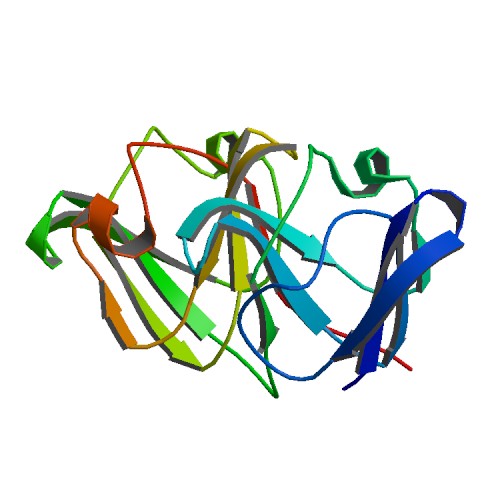Crystallin, gamma D
| Crystallin, gamma D | |||||||||||||
|---|---|---|---|---|---|---|---|---|---|---|---|---|---|
 PDB rendering based on 1h4a. | |||||||||||||
| |||||||||||||
| Identifiers | |||||||||||||
| Symbols | CRYGD ; CACA; CCA3; CRYG4; cry-g-D | ||||||||||||
| External IDs | Template:OMIM5 Template:MGI HomoloGene: 36213 | ||||||||||||
| |||||||||||||
| RNA expression pattern | |||||||||||||
 | |||||||||||||
| More reference expression data | |||||||||||||
| Orthologs | |||||||||||||
| Template:GNF Ortholog box | |||||||||||||
| Species | Human | Mouse | |||||||||||
| Entrez | n/a | n/a | |||||||||||
| Ensembl | n/a | n/a | |||||||||||
| UniProt | n/a | n/a | |||||||||||
| RefSeq (mRNA) | n/a | n/a | |||||||||||
| RefSeq (protein) | n/a | n/a | |||||||||||
| Location (UCSC) | n/a | n/a | |||||||||||
| PubMed search | n/a | n/a | |||||||||||
Crystallin, gamma D, also known as CRYGD, is a human gene.[1]
Crystallins are separated into two classes: taxon-specific, or enzyme, and ubiquitous. The latter class constitutes the major proteins of vertebrate eye lens and maintains the transparency and refractive index of the lens. Since lens central fiber cells lose their nuclei during development, these crystallins are made and then retained throughout life, making them extremely stable proteins. Mammalian lens crystallins are divided into alpha, beta, and gamma families; beta and gamma crystallins are also considered as a superfamily. Alpha and beta families are further divided into acidic and basic groups. Seven protein regions exist in crystallins: four homologous motifs, a connecting peptide, and N- and C-terminal extensions. Gamma-crystallins are a homogeneous group of highly symmetrical, monomeric proteins typically lacking connecting peptides and terminal extensions. They are differentially regulated after early development. Four gamma-crystallin genes (gamma-A through gamma-D) and three pseudogenes (gamma-E, gamma-F, gamma-G) are tandemly organized in a genomic segment as a gene cluster. Whether due to aging or mutations in specific genes, gamma-crystallins have been involved in cataract formation.[1]
References
Further reading
- Graw J (1998). "The crystallins: genes, proteins and diseases". Biol. Chem. 378 (11): 1331–48. PMID 9426193.
- Slingsby C, Clout NJ (2000). "Structure of the crystallins". Eye (London, England). 13 ( Pt 3b): 395–402. PMID 10627816.
- Brakenhoff RH, Aarts HJ, Reek FH; et al. (1991). "Human gamma-crystallin genes. A gene family on its way to extinction". J. Mol. Biol. 216 (3): 519–32. PMID 2258929.
- Shiloh Y, Donlon T, Bruns G; et al. (1986). "Assignment of the human gamma-crystallin gene cluster (CRYG) to the long arm of chromosome 2, region q33-36". Hum. Genet. 73 (1): 17–9. PMID 3011643.
- Lubsen NH, Renwick JH, Tsui LC; et al. (1987). "A locus for a human hereditary cataract is closely linked to the gamma-crystallin gene family". Proc. Natl. Acad. Sci. U.S.A. 84 (2): 489–92. PMID 3025877.
- Meakin SO, Du RP, Tsui LC, Breitman ML (1987). "Gamma-crystallins of the human eye lens: expression analysis of five members of the gene family". Mol. Cell. Biol. 7 (8): 2671–9. PMID 3670288.
- Meakin SO, Breitman ML, Tsui LC (1985). "Structural and evolutionary relationships among five members of the human gamma-crystallin gene family". Mol. Cell. Biol. 5 (6): 1408–14. PMID 4033658.
- Rogaev EI, Rogaeva EA, Korovaitseva GI; et al. (1997). "Linkage of polymorphic congenital cataract to the gamma-crystallin gene locus on human chromosome 2q33-35". Hum. Mol. Genet. 5 (5): 699–703. PMID 8733140.
- Andley UP, Mathur S, Griest TA, Petrash JM (1997). "Cloning, expression, and chaperone-like activity of human alphaA-crystallin". J. Biol. Chem. 271 (50): 31973–80. PMID 8943244.
- Lampi KJ, Ma Z, Shih M; et al. (1997). "Sequence analysis of betaA3, betaB3, and betaA4 crystallins completes the identification of the major proteins in young human lens". J. Biol. Chem. 272 (4): 2268–75. PMID 8999933.
- Stephan DA, Gillanders E, Vanderveen D; et al. (1999). "Progressive juvenile-onset punctate cataracts caused by mutation of the gammaD-crystallin gene". Proc. Natl. Acad. Sci. U.S.A. 96 (3): 1008–12. PMID 9927684.
- Héon E, Priston M, Schorderet DF; et al. (1999). "The gamma-crystallins and human cataracts: a puzzle made clearer". Am. J. Hum. Genet. 65 (5): 1261–7. PMID 10521291.
- Pande A, Pande J, Asherie N; et al. (2000). "Molecular basis of a progressive juvenile-onset hereditary cataract". Proc. Natl. Acad. Sci. U.S.A. 97 (5): 1993–8. doi:10.1073/pnas.040554397. PMID 10688888.
- Kmoch S, Brynda J, Asfaw B; et al. (2000). "Link between a novel human gammaD-crystallin allele and a unique cataract phenotype explained by protein crystallography". Hum. Mol. Genet. 9 (12): 1779–86. PMID 10915766.
- Pande A, Pande J, Asherie N; et al. (2001). "Crystal cataracts: human genetic cataract caused by protein crystallization". Proc. Natl. Acad. Sci. U.S.A. 98 (11): 6116–20. doi:10.1073/pnas.101124798. PMID 11371638.
- Santhiya ST, Shyam Manohar M, Rawlley D; et al. (2002). "Novel mutations in the gamma-crystallin genes cause autosomal dominant congenital cataracts". J. Med. Genet. 39 (5): 352–8. PMID 12011157.
- MacCoss MJ, McDonald WH, Saraf A; et al. (2002). "Shotgun identification of protein modifications from protein complexes and lens tissue". Proc. Natl. Acad. Sci. U.S.A. 99 (12): 7900–5. doi:10.1073/pnas.122231399. PMID 12060738.
- Strausberg RL, Feingold EA, Grouse LH; et al. (2003). "Generation and initial analysis of more than 15,000 full-length human and mouse cDNA sequences". Proc. Natl. Acad. Sci. U.S.A. 99 (26): 16899–903. doi:10.1073/pnas.242603899. PMID 12477932.
| This protein-related article is a stub. You can help Wikipedia by expanding it. |